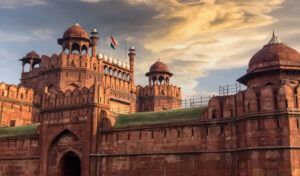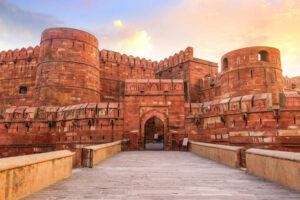
Table of Contents
Red Fort

The Red Fort, or Lal Qila, stands as a majestic symbol of India’s rich history and architectural brilliance. Built by Mughal Emperor Shah Jahan in 1648, this UNESCO World Heritage Site in Delhi represents the grandeur of the Mughal era. Crafted from stunning red sandstone, the showcases intricate carvings, grand halls, and lush gardens.
The fort served as the Mughal empire’s political and cultural center for nearly 200 years. It houses iconic structures like the Diwan-i-Aam, Diwan-i-Khas, and the beautiful Rang Mahal. Today, it remains a significant landmark where India’s Independence Day celebrations are held annually.
A visit to the offers a glimpse into India’s glorious past, blending history, artistry, and patriotism. Its massive walls, ornate palaces, and vibrant markets transport visitors to a time of royal splendor, making it a must-visit heritage site in India.
Historical Significance
The Red Fort was constructed when Shah Jahan decided to shift his capital from Agra to Delhi. Designed by Ustad Ahmad Lahori, the architect behind the Taj Mahal, the was built using red sandstone, which gives it its striking appearance. For nearly 200 years, it served as the main residence of the Mughal emperors and the center of political and cultural activities.
The fort witnessed several historical events, including the decline of the Mughal Empire, the British conquest, and India’s independence movement. It was invaded by the Persian ruler Nadir Shah in 1739, leading to the plundering of its treasures, including the famous Peacock Throne. Later, during the Indian Rebellion of 1857, the British overthrew the last Mughal emperor, Bahadur Shah II, and used as a military base.
The fort played a significant role in India’s independence movement. On August 15, 1947, the first Prime Minister of India, Jawaharlal Nehru, delivered his famous speech from the Red Fort, marking the country’s freedom from British rule. This tradition continues today, as the Prime Minister hoists the national flag from its ramparts every Independence Day, reinforcing the symbolic importance in India’s national identity.
The Red Fort has also served as an inspiration for several historical movements, cultural developments, and architectural innovations over the centuries. Its walls have witnessed the rise and fall of empires, echoing the stories of power, resilience, and transformation. Even today, it stands as a reminder of India’s rich heritage and its journey from a monarchy to an independent democracy.

Architectural Brilliance
Spanning over 250 acres, the Red Fort showcases an extraordinary blend of Persian, Timurid, and Indian architectural styles. Its high defensive walls, spanning approximately 2.5 kilometers, were built to protect the from invaders.
Inside, the fort complex houses several magnificent structures, including:
- Lahori Gate – The main entrance, named after its orientation towards Lahore, Pakistan.
- Delhi Gate – Another grand gateway used for ceremonial purposes.
- Diwan-i-Aam (Hall of Public Audience) – A vast hall where the emperor addressed the common people.
- Diwan-i-Khas (Hall of Private Audience) – A lavishly adorned chamber where the emperor met with courtiers and foreign dignitaries. It once housed the famous Peacock Throne.
- Rang Mahal – A beautiful palace with a marble lotus-shaped fountain, used as the residence for the emperor’s wives and mistresses.
- Moti Masjid – A small but elegant white marble mosque built by Emperor Aurangzeb.
- Khas Mahal and Mumtaz Mahal – Private residences of the Mughal emperor and his queen.
- Hayat Bakhsh Bagh – A lush garden with pavilions and water channels, showcasing Mughal landscaping skills.
The Red Fort Today
Today, the Red Fort stands as a major heritage site in India. Its historical and architectural significance makes it a must-visit destination for tourists and history enthusiasts. The also houses the Red Fort Archaeological Museum, where visitors can explore artifacts from the Mughal era, including paintings, manuscripts, and weapons.
One of the key attractions is the Sound and Light Show, held in the evenings, which narrates the history through an immersive audio-visual experience. This spectacular event brings the Red Fort’s past to life, showcasing the grandeur of Mughal rule and the struggles of India’s independence movement.
The Indian government continues to undertake conservation efforts to preserve the architectural integrity. Various parts of the fort have been restored to reflect their original glory, ensuring that future generations can appreciate its cultural and historical significance.
Visitor Information
- Location: Netaji Subhash Marg, Chandni Chowk, Delhi
- Timings: Open from 9:30 AM to 4:30 PM (closed on Mondays)
- Entry Fee:
- Indians: ₹35
- Foreigners: ₹500
- Children (below 15 years): Free
- Best Time to Visit: October to March (cooler weather for exploring)
- How to Reach: The nearest metro station is Chandni Chowk, from where rickshaws and taxis are available.

How to Reach Red Fort
Reaching the Red Fort is easy, as it is well connected by various modes of transport:
By Metro:
- The nearest metro station is Chandni Chowk Metro Station (Yellow Line), approximately 1 km away. From there, you can take a rickshaw or walk to the fort.
- Another nearby metro station is Lal Qila Metro Station (Violet Line), located just a few minutes’ walk from the fort.
By Bus:
- Several DTC (Delhi Transport Corporation) buses run towards the Red Fort, with stops at Lal Qila or Chandni Chowk.
- Both AC and non-AC buses are available from various parts of Delhi.
By Train:
- The nearest railway station is Old Delhi Railway Station (Delhi Junction), about 2 km away.
- From the station, you can take an auto-rickshaw or cycle-rickshaw to reach the fort.
By Auto-Rickshaw or Taxi:
- Auto-rickshaws and cycle-rickshaws are commonly available around Old Delhi.
- App-based cab services like Ola and Uber provide convenient transport options to the Red Fort.
By Personal Vehicle:
- Visitors driving their own vehicle can park at Jama Masjid Parking or Chandni Chowk Multi-Level Parking, as parking near the fort is limited.
Conclusion
The Red Fort is not just a historical monument but a living testament to India’s glorious past. It represents the grandeur of the Mughal Empire, the resilience of India’s freedom struggle, and the nation’s cultural richness. The is a symbol of India’s heritage and its enduring legacy. Walking through its vast courtyards, intricate palaces, and grand halls, visitors can feel the echoes of history and experience the splendor of a bygone era.
Beyond its historical importance, the Red Fort serves as an inspiration for generations, reminding people of India’s struggle for independence and its triumph over colonial rule. The annual role in Independence Day celebrations further strengthens its significance in modern India.
Whether you’re a history buff, an architecture enthusiast, or a traveler exploring Delhi, the Red Fort promises an unforgettable journey through time. Visiting this monument allows you to witness the magnificence of Mughal craftsmanship, understand India’s historical depth, and appreciate the cultural vibrancy that continues to thrive in its surroundings. A trip to the is not just a walk through history—it is an experience that enriches the soul.

Agra Fort – Historic red sandstone fort of medieval India also known as the Red Fort Agra at sunrise. Agra Fort is a UNESCO World Heritage site in the city of Agra India.
Red Fort Map
Follow More Article
